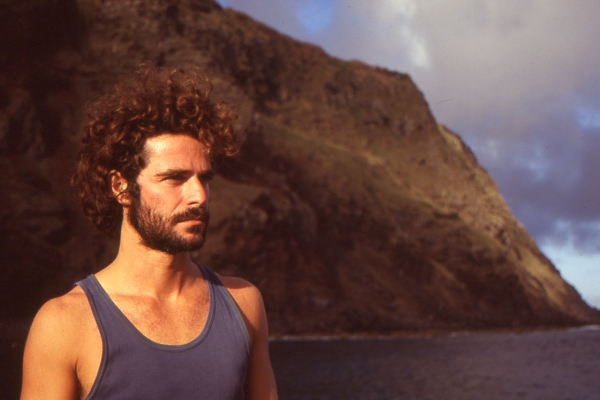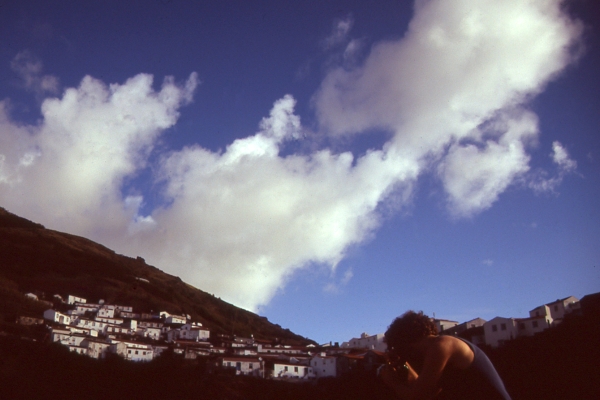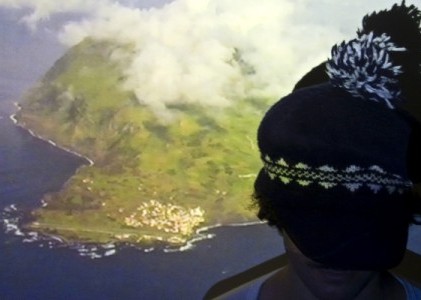Island Time
To start the New Year, the Museum introduces First Look, a new annual showcase curated by Dennis Lim, Rachael Rakes, and David Schwartz. This two-weekend program—which brings together some of the most invigorating and inventive voices in contemporary world cinema, including established and emerging filmmakers—affirms our belief in cinema as a flourishing art form. To supplement the program, Moving Image Source is running a series of essays on all the feature films that are being shown. Check back daily from now through next weekend for new articles.
“We are going to film everything we can.” So says director Gonçalo Tocha as he arrives at the tiny Portuguese island of Corvo, the westernmost point of Europe. The village, population 440, sits between a volcanic crater and the Atlantic Ocean, pinned between an ancient past and the distant present of the mainland, which reaches them only through a thrice-weekly plane landing. It’s the Earth Not the Moon is equally suspended in time, as Tocha urges locals to recreate dead traditions (like hand-knit berets), while sketching an anecdotal history of the island through diaries and personal reminiscences (official records are scarce). This is all woven into the islanders' resigned transition from their farming and whaling past to the real-estate development and nascent tourism of the present. Shot over the course of two years, with a crew of Tocha and his sound man Dídio Pestana, It’s the Earth Not the Moon is an absorbingly inventive three-hour ramble that is both an elegiac act of remembrance and a bulletin of the way things are now.
It is Tocha’s second feature, after Balaou (2007, streaming for free here), a meditative travelogue over the Atlantic in which he grapples with the death of his mother. Balaou is interior and impressionistic where It’s the Earth is exterior and observational, yet his concerns remain consistent. Both films attempt to make memories incarnate, a form of time travel as affecting as it is short-lived. In Balaou Tocha finds his mother’s diary of her first trip through the Azores, and uses it as the template for his journey. With It’s the Earth Not the Moon, Tocha finds Ines Inez (a name she married into), one of the last people on the island who knows how to knit the local, now out-of-fashion whaling berets. Ines becomes the structuring center of the film, as she makes Tocha his own hat, her progress returned to repeatedly through 14 chapters. Once she finishes her work the film, and the tradition, are over.
This process of remembrance and dissolution occurs throughout as Tocha elicits more stories and memories of life on the island. There is the locksmith, who used to construct wooden locks for a village with no crime. His demonstration of their making is a wonder, as the film documents the entire process of turning an innocent block into an intricate bit of analog machinery. This is mastery learned by accumulated experience that creates a now useless product. Then there is the retired cheesemaker, whom Tocha cajoles into producing a few wheels and who notes, “You have to take care of them just like babies,” and the 94-year-old Uncle Pedro, who dusts off and plays his accordion for the first time in ages. The most devastating loss-by-obsolescence, however, was the end of the whaling business, after the decimation of the species. Lookout towers dot their town like ghostly sentinels, and one former spotter declares of the whales, “I still dream with them.” He later backtracks from such sentimentality (“You want more lies?”) but this sense of being haunted by the ocean and its former bounty creeps through the village. One sequence finds a group staring at a video of the tide crashing into the docks, as it rises with each return. As Tocha documents their obsessive rapture, a woman brings the director a whole photo album of past crestings, chronicles of their town’s constant vulnerability, the land open to erasure as much as their traditions.

Gonçalo Tocha in It's the Earth Not the Moon
As in Balaou, Tocha is mainly a vocal presence, sparsely narrating events in a soft-spoken monotone with Pestana, trying to be a courteous guest rather than the center of attention. The frequent iris shots, as if lensed through a telescope, are another indicator of his observing presence, an attempt at distancing himself from material he clearly has a deeply personal attachment to, as part of his family lives on the Azorean island of Sao Miguel. These shots are used to itemize the uncanny beauty of Corvo’s volcanic landscapes, with intense, almost neon-green foliage blanketing the caldera. Ventures outside the village discover small pockets of wanderers and tourists, including an isolated retreat for members of a dance company, who mimic the motions of the undulating topography and who, as Tocha wryly notes, never visit the town. Then there are the birders attracted by rare species, who excitably tramp through fields in explorer gear, looking like a herd of middle-aged L.L. Bean catalog models. These lyrical but dispiriting interludes are the likely future of Corvo’s economy, which is sustained by scant government investment and little else.
Efforts to spark development come to the fore in a section on an upcoming election, as Tocha turns his lens, for the first extended period, to the future. The debate centers on real-estate development, or the lack of it, with proposals for multi-use arts facilities and after-school community centers taking up most of the attention. Tocha focuses on the Communist Party efforts to get out the vote. One fiery CP candidate complains about how low pay at the cheese factory made her and the majority of employees quit, and it is now run by inexperienced, cheap labor (which ran the artisanal cheesemakers out of business). When every vote actually does count (elections are won by single digits), candidates are vocal and the citizens engaged (one local says there should be a vote every month), but there is little hope the government will make a difference. Politics are treated as a diverting entertainment rather than a viable vehicle for change. The mood is summarized by a struggling workman, who laments, "Europe is over. Europe is burnt." He says he’s moving to Angola for a job.

Gonçalo Tocha in It's the Earth Not the Moon
With the older generation fading away, it is up to the young to sustain Corvo, but they appear more as specters than engaged members of society. There are children, racing through the town square, and receiving singing lessons, but hardly any youths and teenagers (some have presumably fled to the mainland). They make fleeting appearances in a nightclub, dancing to bad karaoke in a smoky strobing light, perhaps in town to visit family. Late in the film, Tocha fixes his camera on a gray sedan. A young man steps inside, a parade of lights sprinkle its sides, and dance music booms. It is a sign of youth, and then it drives away. In voiceover, Tocha says, "He should have stayed longer…"
The Municipal Council records of Corvo, a 500-year-old village, date back only 200 years, and part of those files were destroyed in a fire. It’s the Earth Not the Moon’s great accomplishment is to imagine this lost history through the hands, faces, and personalities of its current residents, a creative remaking of the past that still captures the concrete realities of the present. Tocha ends the film in this state of temporal in-betweenness. He discovered a 1970s documentary that filmed portraits of local residents, and contrasts those with shots of the same people today: a parade of craggy, smiling faces. As the archival footage continues, older faces appear, of those that have passed on, whose forgotten lives can only be dreamed. It is here that Tocha receives his beret. He is finally a "true man of Corvo," as Inez tells him. The final shot shows him wearing the century-old style in shadow, centered in a twirl of spinning lights, as if at the center of the sun, as a techno beat rumbles on the soundtrack. Time folds in on itself, and the whaler hits the dance floor. ![]()
LATEST ARTICLES
-20140814-173707-thumb3.jpg)
Fighting Words
by Imogen Sara Smith
posted August 12, 2014

Fighting Words, Part 2
by Imogen Sara Smith
posted August 20, 2014

On the Margins: The Fil…
by Andrew Chan
posted August 12, 2014

Robin Williams: A Sense…
by David Schwartz
posted August 12, 2014
 Island Time
Island Time
RELATED ARTICLE
Jungle Fever by Andréa PicardGoing the Distance by Scott MacDonald
Glass Houses by Michael Sicinski
Darkness Doubled by Leo Goldsmith
Ghost World by Colin Beckett
Unplugged by Phil Coldiron
A Nude by Garrel by Eugenio Renzi
Twilight Zone by Robert Koehler
Family Viewing by Mark Peranson
Capitalist Punishment by Shelly Kraicer
Her Own Devices by Robert Koehler
The Fallen by Phil Coldiron
The 1 Percent Solution by Michael Sicinski
More: Article Archive
THE AUTHOR
R. Emmet Sweeney writes a weekly column for Movie Morlocks, the official blog of Turner Classic Movies. He has also contributed to Film Comment, Time Out Chicago and The Believer.
More articles by R. Emmet SweeneyAuthor's Website: Movie Morlocks

